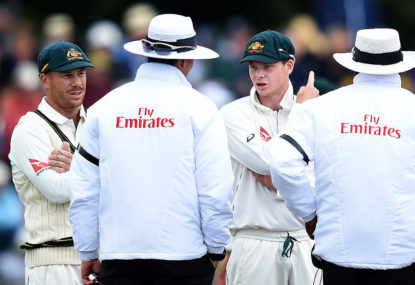Calamitous miss as Lucknow botch near certain run out with the game on the line
With Rajasthan needing 25 off 17, both batsmen ended up at the same end but the bowler dropped the throw from his teammate -…

The review system has revolutionised the game of cricket since its inception in late 2009, but there’s been ever-increasing opinion regarding the ‘umpire’s call’. Can it be bettered?
As it stands, each side gets two successful reviews to play with, meaning if you get your review right then you can keep it, but if it’s a wrong call then you lose it.
Simple, right?
But there’s one little factor that gets the ire of most cricket fans around the world – and it’s often a deciding factor in the majority of decisions.
Umpire’s call comes into play in LBW decisions, which make up 90 per cent of reviews, and comes into effect if less than half the ball is hitting the wicket. The issue is the aura of doubt surrounding ball tracking.
While the technology is extremely good, and does its best to read and predict the path of the ball, there is always going to be a shadow of possible error.
It can never be 100 per cent accurate, that’s just the way it is, so the system is set up to accommodate this.
But the issue here is the challenge itself.
Teams lose their challenge for an incorrect decision, including if it’s deemed umpire’s call. But if that’s a benefit of the doubt call, then why shouldn’t the challenger get the same benefit?
If it comes up as the orange umpire’s call symbol, that’s not saying that the challenge is wrong, it’s basically an ‘I don’t know’.
It says ‘umpire’s call’ because the system is too close to accurately come up with a certain result, so it’s given back to the umpire to defend their decision.
If that’s the case, then the challenging player is technically not wrong, and that means that they shouldn’t lose the challenge.
Should a team retain a challenge if it goes to umpire’s call? Or is it just bad luck?
Many are quick to point out that if the ump’s finger had have gone up, or stayed down, whatever the situation, then the final decision would have gone the other way.
So neither party can be wrong or right, it’s just the way the umpire calls it and that’s what the entire review system was brought in to oppose.
That air of disconnect between out and not out so often will cost a review, because the decision falls in that cloudy area where no one knows what’s happening.
In the same vein, traditionalists will beat up the system because it moves away from what the game has traditionally been and should be: two teams and two umpires.
The umpire’s call is what you get and people should deal with it.
The system, for lack of a better word, degrades the umpires and calls out everything they do wrong, highlighting it and putting doubt in their minds for future decisions.
It’s a tight line, but a team should be allowed to keep their review if umpire’s call comes up.